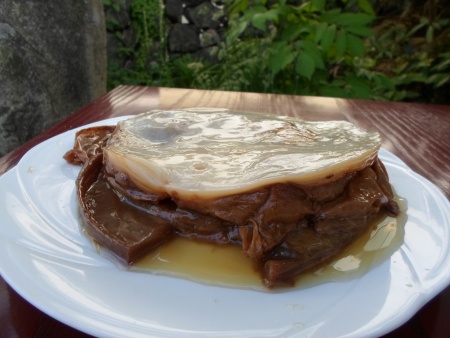Kombucha: Difference between revisions
No edit summary |
No edit summary |
||
| Line 2: | Line 2: | ||
[[Image:450px-Kombucha_mother_burdger_view_kasiri_south_korea_1600_1200_fa20052013.jpg|left| Kombucha SCOBY (culture taken out from the brew)]] | [[Image:450px-Kombucha_mother_burdger_view_kasiri_south_korea_1600_1200_fa20052013.jpg|left| Kombucha SCOBY (culture taken out from the brew)]] | ||
'''Kombucha''' is a microbial polyculture composed from variety of bacteria and yeast. Traditionally it proliferate by consumption of sugar (for example sucrose/saccharose) and black tea dissolved in liquid water medium. This symbiotic complex and especially '' | '''Kombucha''' is a microbial polyculture composed from variety of bacteria and yeast. Traditionally it proliferate by consumption of sugar (for example sucrose/saccharose) and black tea dissolved in liquid water medium. This symbiotic complex and especially ''Gluconacetobacter xylinum'' is producing microcellulose biofilm which is floating on the top of the brew. White thick compact biofilm generally represents good and healthy culture - from the point of view of stability and final flavor of the brew. Some brewers are suggesting that it is serving as a protection against oxygen from the air and it's floating capacity is due to the absorption of carbon dioxide produced by the microbes in the beverage. | ||
The health benefits of kombucha beverages are widely discussed. From personal experience of many consumers they experience direct positive effect on digestion especially after eating heavy fatty meals. If the brew is stronger, therefore it's pH is lower people with sensitive tooth should be careful and drink some other beverages to wash their mouths or they tooth may become too sensitive and cause uncomfortable sensations for few hours. | The health benefits of kombucha beverages are widely discussed. From personal experience of many consumers they experience direct positive effect on digestion especially after eating heavy fatty meals. If the brew is stronger, therefore it's pH is lower people with sensitive tooth should be careful and drink some other beverages to wash their mouths or they tooth may become too sensitive and cause uncomfortable sensations for few hours. | ||
Revision as of 04:39, 6 December 2014
Kombucha is a microbial polyculture composed from variety of bacteria and yeast. Traditionally it proliferate by consumption of sugar (for example sucrose/saccharose) and black tea dissolved in liquid water medium. This symbiotic complex and especially Gluconacetobacter xylinum is producing microcellulose biofilm which is floating on the top of the brew. White thick compact biofilm generally represents good and healthy culture - from the point of view of stability and final flavor of the brew. Some brewers are suggesting that it is serving as a protection against oxygen from the air and it's floating capacity is due to the absorption of carbon dioxide produced by the microbes in the beverage.
The health benefits of kombucha beverages are widely discussed. From personal experience of many consumers they experience direct positive effect on digestion especially after eating heavy fatty meals. If the brew is stronger, therefore it's pH is lower people with sensitive tooth should be careful and drink some other beverages to wash their mouths or they tooth may become too sensitive and cause uncomfortable sensations for few hours.
Based on experience the optimal growing temperature for kombucha to obtain beverage of good taste is around 20°C, ranging between 15-25°C. With prolonged temperature above 25°C the brew may become too acidic and the biofilm change it's structure. Hot humid summers in subtropical and definitely tropical regions may be very challenging for working with this culture.
If you would like to brew our own, variety of manuals exist, here is for example one used by our group - Kombucha brewing manual - short workshop form.
